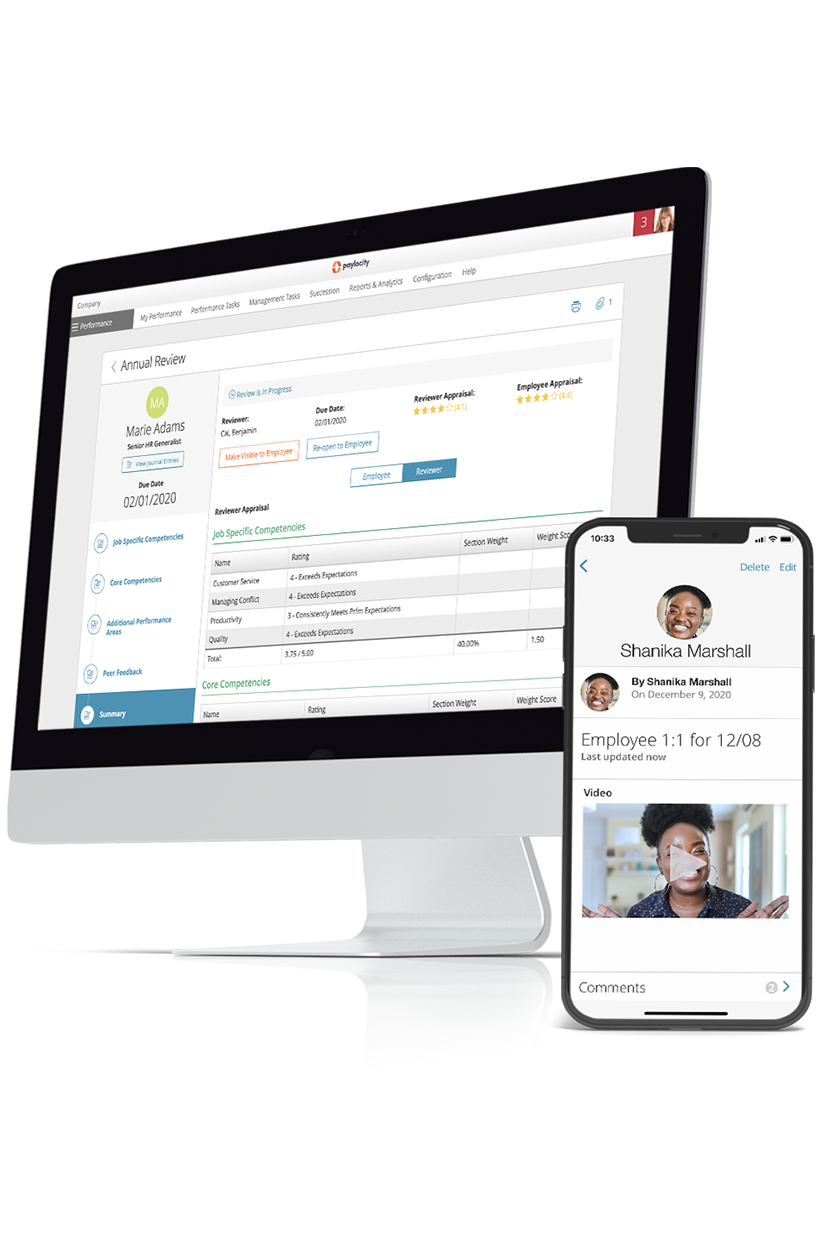resources
Performance Management: Pros and Cons of Employee Self-Evaluation
March 10, 2023
Learn the benefits (and challenges) of employee self-evaluation and the tools that make the performance review process easier for managers and employees.
Blog Post

Skip to end of table of contents
Table of Contents
- What is an Employee Self-Evaluation?
- How Does Self-Appraisal Work?
- What's Included in Writing an Employee Self-Evaluation?
- Examples of Employee Self-Evaluation
- What Are the Advantages of an Employee Self-Assessment?
- What Are the Disadvantages of an Employee Self-Assessment?
- How to Encourage Employees to Write a Self-Evaluation
- Best Practices in Creating Employee Self-Evaluation Forms
- Leverage Self-Assessments for Performance Reviews
Does anyone enjoy writing a self-evaluation?
Truth be told, most workers especially dread this part of the employee review process. It's difficult to rate your own performance honestly. However, when thoughtfully planned and applied, the self-evaluation process can offer management and employees some great benefits.
To make the most of employee self-evaluations, the first key is knowing how to administer and encourage honest self-assessment as part of your company’s performance review process. The second is encouraging employees and supervisors to use the information in a value-based way to guide career development.
An employee performance management system not only streamlines the whole review process, it also can engage employees. While technology can’t make your workers fill out a self-evaluation, it can help them take ownership of their career development and also gives managers the tools to support them.
What is an Employee Self-Evaluation?
An employee self-evaluation, also called a self-assessment, is a formalized opportunity for employees to reflect on their contributions to your organization and document those contributions in writing or as a digital file.
These employee evaluations typically take place at least once a year and are often included in the yearly review process to build out a full picture of the employee’s accomplishments and learning opportunities. Employees’ self-assessment of their work can provide valuable insights into next steps for professional development.
How Does Self-Appraisal Work?
Managers or HR teams create self-appraisal forms for each employee, often using a company-wide template. These forms ask employees to evaluate their performance over a given time period, such as the previous year, half-year, or quarter.
Employees may be asked to rate themselves on a numerical scale, to answer open-ended questions about their performance, or to list their strengths and weaknesses. The form might refer to specific tasks and targets, and there may be space for explanations (such as a target not being met due to unrealistic expectations or lack of resources).
Once the form is complete, the employee submits it to their manager or supervisor. This typically happens ahead of a performance review meeting between employee and manager, where the evaluation is discussed in detail. The manager may have used an identical form to give their opinion of the employee’s performance, in which case the two forms can be compared at the meeting.
The meeting is a chance for both parties to give additional feedback and discuss the employee’s career goals and professional development. Insights from the process can be used for making business improvements, such as setting clearer goals or offering extra training.
What's Included in Writing an Employee Self-Evaluation?
When it comes time to review employee performance, clarifying which aspects you’d like your employees to review can set everybody up for a successful experience.
Here’s what to include in your employee self-evaluations:
- Accomplishments—how has the employee contributed to the team environment and overall success of the organization?
- Opportunities to learn—have they identified gaps in their skill set or areas where they’d like to improve?
- Goals—what do they want to achieve next in terms of performance, position, or project?
- Feedback—what insights do they have about workplace culture, operations, and collaboration?
Providing employees the opportunity to self-reflect can empower them to take ownership of their contributions to your organization and operate at the top of their skill sets and capabilities.
Examples of Employee Self-Evaluation
Self-evaluation forms can come in various formats:
- A rating scale
- Open-ended questions
- Hybrid forms
In a rating system, employees are given a list of statements, job duties, or personal characteristics, and asked to rate themselves on a numerical scale (such as one to ten) or categorize their performance as “Poor/Adequate/Good/Excellent”.
This is a simple method, but it can still be affected by bias and subjectivity. For example, women are more likely than men to give themselves a low rating. Or one employee might consider 7 out of 10 to be a great score, while another thinks it’s a failure.
Using the same rating scale across the organization helps keep the performance review process fair for all employees — as long as managers are using the scale consistently. It also provides a wealth of data to help you identify performance gaps.
Open-ended questions encourage more detailed answers, so employees can put more thought into assessing their strengths and weaknesses. This helps to give employees a voice, as they have the chance to explain why they’re particularly good at a job or why they couldn’t complete a task. A qualitative type of appraisal offers more in-depth discussion points.
Hybrid self-evaluations combine the two types, enabling managers to gather both quantitative and qualitative information. In a best-of-two-worlds scenario, the scoring section doesn’t take too long to fill in, but the employee still has the chance to expand on a question or give additional feedback.
What Are the Advantages of an Employee Self-Assessment?
A self-assessment, when completed without bias and with the goal of improvement, can be an excellent performance review tool for both employees and management. It can help employees reflect on their strengths and weaknesses and create goals that will fuel personal and professional growth.
Three major benefits of a self-evaluation include:
1. Provides Employees Better Data Insights
With a self-evaluation, the employee needs to consider different projects and tasks they completed and compare their recollections to the data associated with those projects. It gives them the chance to look at their performance through the eyes of management, which is a perspective they normally don't have. This can be an excellent teaching tool to improve skills and it can also lead to growth in areas of management and leadership.
2. Considers the Employee's Perspective
Managers and supervisors don't always know or understand the day-to-day duties of their individual employees. A self-evaluation is a great communication tool that can help managers discover gaps between their expectations and an employee’s actual responsibilities.
3. Gives the Employee a Voice
This is a key benefit. The self-evaluation process opens a line of communication for the employee to give feedback on their performance, but also the intricacies of their job. This can help management understand pain points for employees and highlight strengths and weaknesses for specific staff members.
Self-assessments are often part of the overall employee evaluation process and include their performance review. Management and HR can use this information to encourage growth, reward excellent productivity, and as a part of the consideration process in promotions.
By using an employee-focused performance tool like Journals, employees can keep record of their tasks, goals and accomplishments, and discuss them with their managers on an ongoing basis.
What Are the Disadvantages of an Employee Self-Assessment?
Many companies use employee self-assessments, but often not to their advantage. For the most part, no one really wants to assess their own performance. It's uncomfortable. Speaking highly of your own performance can be awkward, even when it's true. Pointing out your own flaws can feel like a bad idea in a professional setting.
The outcome is that many employee self-assessments aren't done well or used to their best benefit. The key in making self-assessments useful is in creating an environment where there is no negative judgment on honest assessment. The goal of improvement and growth should be highlighted.
With that being said, there are some challenges that can make employee self-evaluations less productive:
Self-Reflection Is Hard
This is common and often not intentional. Employees often don't feel comfortable assessing their own performance. Even more, they may not know exactly how to complete a self-appraisal. HR and supervisors should make sure to give the employee the tools they need, such as data and examples, to help them compile the most valuable assessment.
It's Difficult to Eliminate Bias
You're not going to get a completely unbiased self-assessment. It's not possible to remove yourself entirely from an assessment of your own performance.
For some employees, it may mean that they don't showcase their strengths as well as they should because it feels braggy. For others, it might mean that they simply do not see their own weaknesses.
Managers need to be on the lookout for places where employees downplay their accomplishments — or their skill gaps.
How to Encourage Employees to Write a Self-Evaluation
Employees may feel nervous about the reaction to their self-appraisal, especially if they’re giving negative feedback or asking for support.
To encourage them to take part in the self-evaluation process, you must make it absolutely clear that their opinions won’t come back to bite them. Show them that you only want to help them succeed.
Tell your staff exactly how the process will work. When’s the deadline for submitting the evaluation? Who’s going to be reading it? Will it be a permanent record? What happens at the follow-up meeting? Will the self-evaluation influence future promotions or bonuses?
Being honest about one’s own strengths and weaknesses isn’t easy, so explain why self-evaluation is important and the benefits it brings. For instance, employees can flag achievements that have gone unnoticed, and make sure their hard work is recognized. If they ask for help in overcoming a weakness or reaching a career goal, they can get the resources they need.
Both managers and HR should help apprehensive employees by offering tips or training on the best way to write a self-evaluation and providing examples of effective ones.
Best Practices in Creating Employee Self-Evaluation Forms
Although self-evaluation forms will differ between companies and industries, there are some best practices that apply to all organizations.
- Don’t forget the basics! Your forms must have space for important information such as the employee’s name, department, and position. Specify the review period and the date the evaluation was reviewed together in person. Leave room for signatures and additional comments!
- Instead of using a numerical scale, use ratings like “Exceeds Expectations/Often Exceeds Expectations/Consistently Meets Expectations/Needs Development.” Employees can then focus less on their “grade.”
- Whatever type of rating system you use, make sure employees and managers understand the scale. Provide a detailed explanation of what each score means with examples of what type or level of activity would qualify
- Consider tailoring your forms to different groups based on competencies, which can vary widely between different departments and between junior and senior employees. Tailored self-evaluations are fairer and more effective—but the forms must be consistent in terms of the rating system, the type of information asked for, and the opportunities to give feedback. Otherwise, you risk being accused of discrimination.
- Train managers on how to create and interpret evaluation forms, so that they can provide employees with the necessary guidance. This includes how to give constructive criticism, and how to navigate discrepancies (for example, if an employee rates themselves as a 10 and the manager says six!)
Leverage Self-Assessments for Performance Reviews
The performance review and self-assessment process is an important tool to build employee engagement and encourage growth. But it absolutely needs to be managed professionally and with best practices in leadership.
Recommendations for improvement need to be handled with care so that the employee feels supported and motivated to make changes.
Your performance management system should offer assessment tools that make the performance review process easier to navigate for both managers and employees.
A modern system will allow you to construct unique workflows that help your HR team set goals with your employees, manage benchmarks, and clearly see progress. Communication is essential so that your employees always feel supported as they participate throughout the whole performance review process.
When used effectively, an employee assessment tool can help management compile robust reporting options, so they have a better view of individual performance, as well as whole company productivity.
Request a demo to learn more about Paylocity’s employee performance management software!

Level Up Employee Performance
Help your employees unlock their true potential with modern performance management tools. From goal management to personalized performance review and Journals, our solutions facilitate transparent, two-communication and get your workforce involved in their own development. Employees want to grow and expect ongoing support - give it to them with Performance Management from Paylocity.


